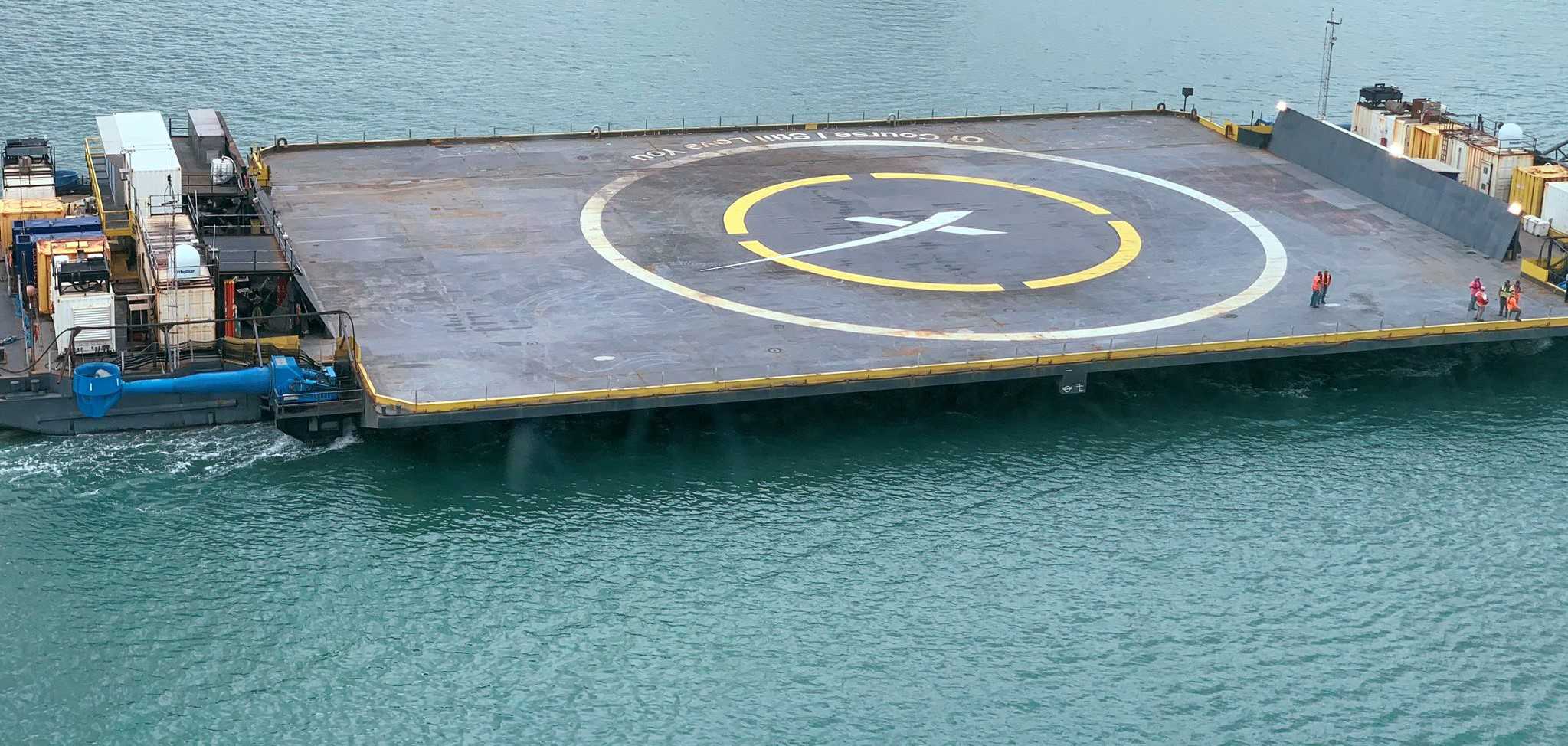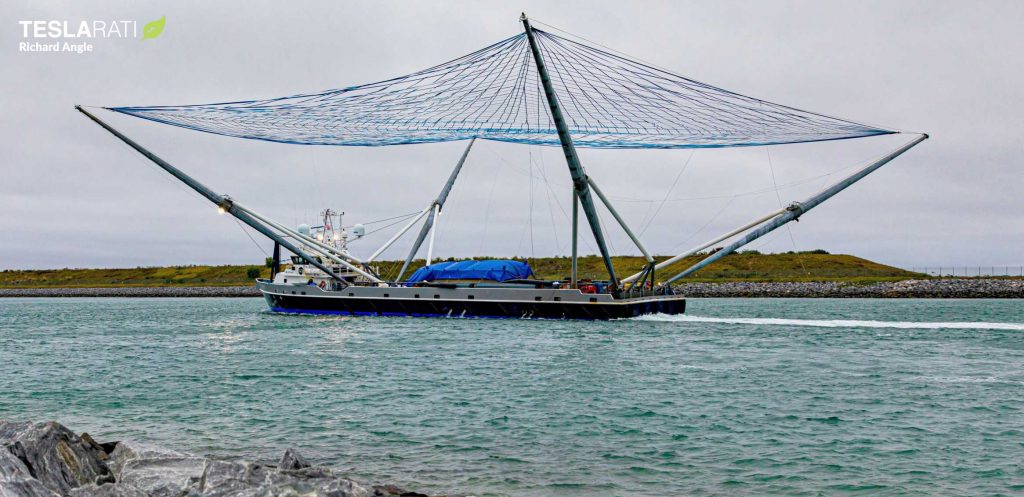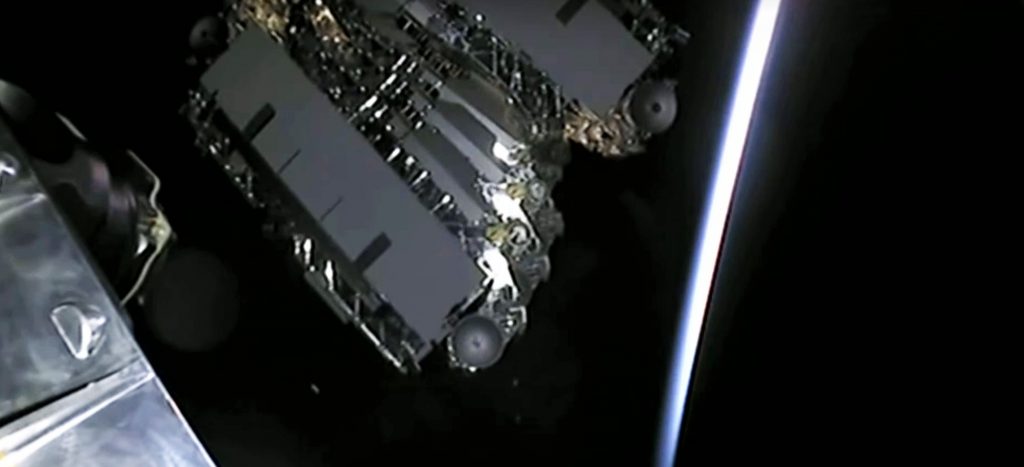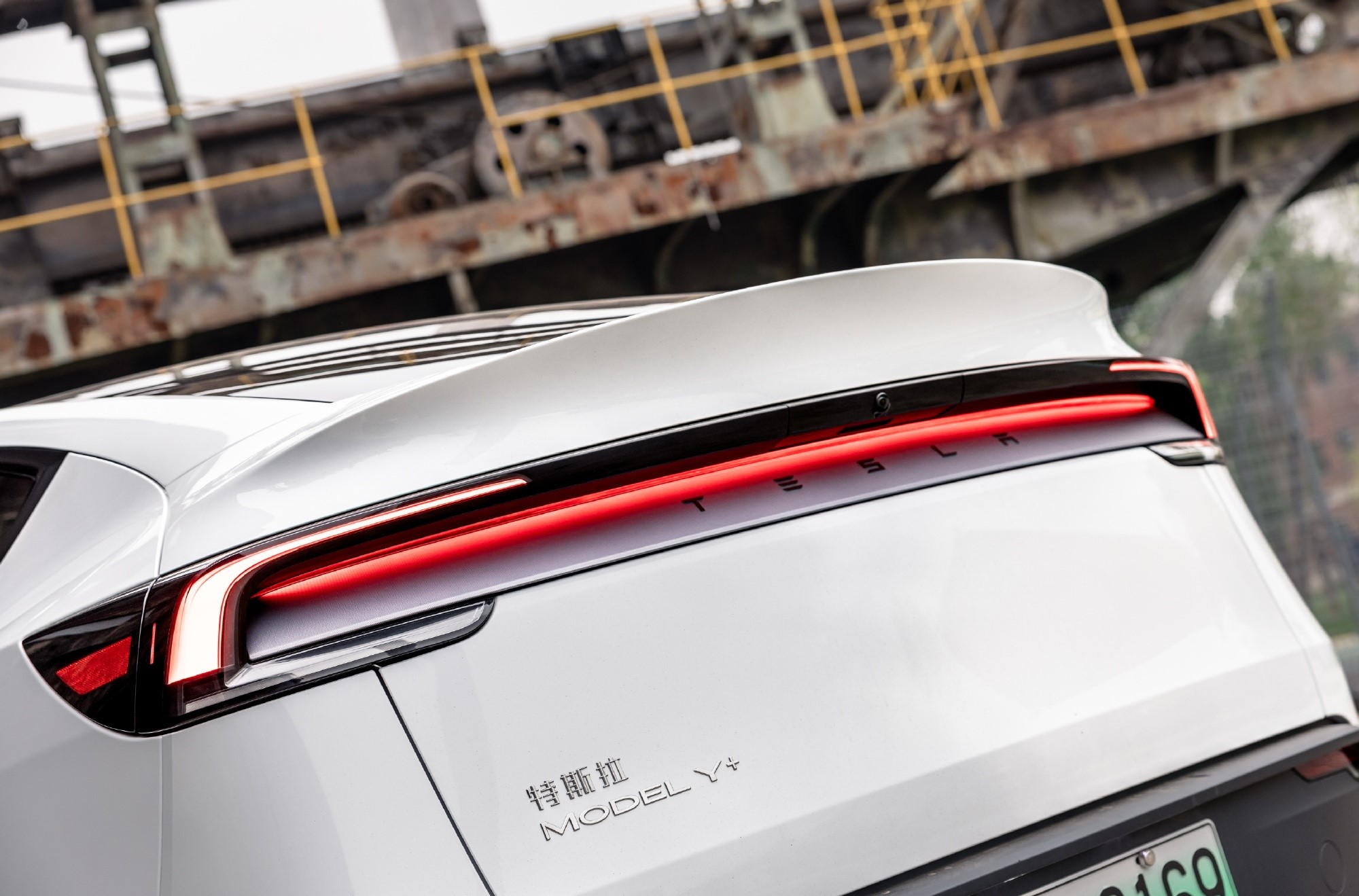

News
SpaceX rings in the New Year with preparations for first Falcon 9 launch of 2020
SpaceX’s first Falcon 9 launch of 2020 – and the new decade – is just around the corner after drone ship Of Course I Still Love You (OCISLY) departed Port Canaveral on Monday to prepare for its 27th booster landing attempt.
Known as Starlink-2, SpaceX’s first launch of the new year slipped a handful of days from December 30th to January 3rd and finally January 6th and will be the company’s second launch of 60 upgraded Starlink v1.0 satellites, as well as the third dedicated Starlink launch overall. Just one of potentially dozens of SpaceX launches planned in 2020, the year is setting up to be – by a long shot – the company’s most ambitious year ever.
Meanwhile, Starlink-2 alone is set to ring in at least two significant milestones, pushing the nascent broadband internet constellation a step closer to serving customers and Falcon 9 reusability a step closer to being fully realized.
Drone ship OCISLY departed Port Canaveral on December 30th and is now being towed some 630 km (390 mi) downrange to Falcon 9’s planned Atlantic Ocean recovery location. SpaceX’s first launch and landing of 2020 will also be the three-year-old drone ship’s 27th attempted Falcon booster recovery and – hopefully – 23rd successful recovery.
Simultaneously, SpaceX technicians are in the midst of preparing other recovery fleet assets for what appears to be a partial fairing recovery attempt. Twin fairing catchers Ms. Tree and Ms. Chief debuted on their first simultaneous fairing catch attempt in December 2019 but each unfortunately missed their catches, instead picking up the floating fairing halves off the surface of the Atlantic and returning to port on December 18th.

The fairing halves were thus still successfully recovered and may be able to fly again on a future Starlink mission, but both fairing recovery ships suffered damage during their first simultaneous deployment. Ms. Tree suffered minimal damage in the form of tears to its secondary net – an easy fix – but Ms. Chief was not as lucky and somehow lost one of the two white booms that support each of her four arms.
That wounded arm was visibly hanging lower than its companions when Ms. Chief returned to port and technicians have since removed all of her arms, presumably evaluating whether the ordeal overstressed any components or caused significant damage.
Unsurprisingly, Ms. Chief will reportedly not take part in the fairing recovery portion of SpaceX’s imminent Starlink-2 launch, although it’s starting to look like Ms. Tree will be able to attempt a catch. SpaceX will still attempt to extract both fairing halves from the Atlantic even if the catch attempt fails and appears to be preparing GO Navigator to recover the half that would have otherwise been assigned to Ms. Chief.
Two milestones, one launch
As implied by the Starlink-2 title, SpaceX’s first launch of 2020 will feature the third batch of 60 Starlink satellites. Excluding 9 Starlink v0.9 satellites that have been intentionally lowering their orbits over the last several months to hasten reentry, this will give SpaceX a constellation of at least 170 operational satellites less than eight months after the company began launching the satellites.

This may not immediately seem significant but 170 operational satellites in orbit could make Starlink the world’s largest satellite constellation and SpaceX the world’s largest constellation operator. The only known competitor that comes close is Planet Labs, an Earth observation company believed to have approximately 150-170 operational satellites in orbit – most of which are 5-10 kg (10-20 lb) ‘Doves’ roughly the size of a loaf of bread.
Put another way, after Starlink-2, SpaceX will have around 45 metric tons (100,000 lb) of functional Starlink satellites in orbit, a constellation mass probably only rivaled by major geostationary commsat operators, global navigation satellites, and a few other high-value military constellations.
Meanwhile, according to NASASpaceflight.com, SpaceX has assigned Falcon 9 booster B1049.3 to its Starlink-2 mission, meaning that the launch will mark the second time that a single SpaceX rocket has flown four orbital-class missions. This follows on the footsteps of the November 11th, 2019 Starlink-1 launch, which saw Falcon 9 B1048 become the first booster to fly four times.
At this point, SpaceX has two additional Starlink launches scheduled in January and has plans for as many as 38 orbital launches throughout 2020. To complete that incredibly ambitious manifest, SpaceX will have to dig deep into its fleet of reusable rockets, meaning that Falcon 9 B1049’s imminent fourth launch is almost certainly just the tip of the iceberg. Falcon 9 B1049 is scheduled to launch SpaceX’s Starlink-2 mission no earlier than (NET) 9:20 pm ET, January 6th (02:20 UTC, Jan 7).
Check out Teslarati’s Marketplace! We offer Tesla accessories, including for the Tesla Cybertruck and Tesla Model 3.
News
Tesla opens massive solar Supercharger station in California
The Supercharger opened to customers ahead of Fourth of July weekend, while Tesla continues phase two of construction on the site.

Tesla has officially launched the first several Supercharging posts at a massive station in California, notably including solar canopies and grid-scale batteries to offer completely renewable charging.
Last week, Tesla announced on X that it opened the first 84 Supercharger stalls of a planned 168-stall station in Lost Hills, California. Additionally, the massive Supercharger project features 11MW of solar canopies and 10 Megapack batteries for off-grid charging powered entirely by solar energy.
Tesla completed the first phase of the project just days ahead of the busy Fourth of July holiday weekend, adding that initial construction took just eight months. In addition to the remaining charging stalls, Tesla says it’s building a set of lounge areas, renderings of which can be seen below alongside current photos of the site.
Notably, the site also includes V4 charging posts for the company’s latest available charging speeds, and it’s located near the busy junction between I-5 and Highway 46 in Kern County.
“Thank you [Kern County] and [PG&E] for collaboration and approvals,” Tesla wrote in a follow-up post.

Credit: Tesla Charging | X

Credit: Tesla Charging | X

Credit: Tesla Charging | X

Credit: Tesla Charging | X
Tesla Supercharger Maps for North America, Europe, and Asia pic.twitter.com/0U5r0XRPyo
— TESLARATI (@Teslarati) July 2, 2025
READ MORE ON TESLA SUPERCHARGERS: Tesla launches ultra-fast V4 Superchargers in China for the first time
Testing at the LA Diner, plus Musk update on potential Tesla solar Gigafactory
The huge Tesla Supercharger station completed phase one of construction fairly quickly, especially given how long Tesla has been working on its unique Los Angeles diner, drive-in, and Supercharger location. Still, the company was seen performing some testing at the nearly-completed charging station earlier this month, and will reportedly be holding a job fair.
Elon Musk also responded on Monday morning to a post on X, suggesting that Tesla is “thinking about” building a U.S.-based solar Gigafactory in order to help support increased power needs with AI growth, and to bolster domestic solar production.
Tesla is building a new UFO-inspired Supercharger in the heart of Alien country
News
Tesla driver walks away from major accident with minor injuries
The driver sustained only minor injuries, and the exact cause of the crash remains under investigation.

The driver of a Tesla Model Y survived and walked away from a harrowing accident on Monday in California, only sustaining minor injuries despite the vehicle being impaled by a guardrail.
On Monday morning around 4:34 a.m., the Los Banos division of the California Highway Patrol (CHP) responded to the accident on I-5 near Panoche Road, involving a 23-year-old in a Tesla Model Y. According to a post on social media, the driver veered off the road for unknown reasons in the northbound lane, before crashing directly into the guardrail and impaling the vehicle.
You can read the full message and photos from Los Banos CHP below, as were shared in a Facebook post on Monday afternoon.
This morning a Tesla model y was traveling in the #1 northbound lane of I-5 north of Panoche Rd. For unknown reasons driver allowed V-1 to veer off the roadway, travel through a dirt center divide, and crashed into the fixed metal guardrail. Lucky for the driver he only sustained minor injuries and was able to walk away. Driving a vehicle requires 100% attention to the road. Avoid distractions and focus on driving.

Credit: CHP Los Banos (via Facebook)

Credit: CHP Los Banos (via Facebook)

Credit: CHP Los Banos (via Facebook)
In a statement to SFGate, CHP officer Myles Anderson said that the driver only sustained minor injuries, while no arrests are made and drugs and alcohol are not suspected to have been involved. The report also notes that Tesla’s “cruise control and lane assistance features” were activated, according to Anderson. However, it’s not entirely clear if this is referring to Supervised Full Self-Driving (FSD), or to the cruise control and lane assist features baked into Autopilot.
At the time of writing, CHP has not yet responded to Teslarati’s request for clarification and additional details on the matter.
Tesla Crash Safety Ratings across its lineup: pic.twitter.com/ny30R7ceji
— TESLARATI (@Teslarati) July 1, 2025
READ MORE ON TESLA SAFETY: Tesla rolls out crucial new safety feature aimed at saving children
The news comes after Tesla has touted its vehicles as incredibly safe for many years. In December, for example, the company highlighted receiving top safety scores from regulators on four different continents throughout the world, including from the National Highway Traffic Safety Administration (NHTSA) and the Insurance Institute of Highway Safety (IIHS) in the U.S.
Tesla has also listed the goal of making its vehicles the safest on the road throughout the years, both in the overall design of its vehicles and in its Autopilot and Full Self-Driving (FSD) programs.
Tesla Model 3 ranks as the safest new car in Europe for 2025, per Euro NCAP tests
Investor's Corner
Cantor Fitzgerald maintains Tesla (TSLA) ‘Overweight’ rating amid Q2 2025 deliveries
Cantor Fitzgerald is holding firm on its bullish stance for the electric vehicle maker.

Cantor Fitzgerald is holding firm on its bullish stance for Tesla (NASDAQ: TSLA), reiterating its “Overweight” rating and $355 price target amidst the company’s release of its Q2 2025 vehicle delivery and production report.
Tesla delivered 384,122 vehicles in Q2 2025, falling below last year’s Q2 figure of 443,956 units. Despite softer demand in some countries in Europe and ongoing controversies surrounding CEO Elon Musk, the firm maintained its view that Tesla is a long-term growth story in the EV sector.
Tesla’s Q2 results
Among the 384,122 vehicles that Tesla delivered in the second quarter, 373,728 were Model 3 and Model Y. The remaining 10,394 units were attributed to the Model S, Model X, and Cybertruck. Production was largely flat year-over-year at 410,244 units.
In the energy division, Tesla deployed 9.6 GWh of energy storage in Q2, which was above last year’s 9.4 GWh. Overall, Tesla continues to hold a strong position with $95.7 billion in trailing twelve-month revenue and a 17.7% gross margin, as noted in a report from Investing.com.
Tesla’s stock is still volatile
Tesla’s market cap fell to $941 billion on Monday amid volatility that was likely caused in no small part by CEO Elon Musk’s political posts on X over the weekend. Musk has announced that he is forming the America Party to serve as a third option for voters in the United States, a decision that has earned the ire of U.S. President Donald Trump.
Despite Musk’s controversial nature, some analysts remain bullish on TSLA stock. Apart from Cantor Fitzgerald, Canaccord Genuity also reiterated its “Buy” rating on Tesla shares, with the firm highlighting the company’s positive Q2 vehicle deliveries, which exceeded its expectations by 24,000 units. Cannacord also noted that Tesla remains strong in several markets despite its year-over-year decline in deliveries.
-

 Elon Musk1 week ago
Elon Musk1 week agoTesla investors will be shocked by Jim Cramer’s latest assessment
-

 News2 weeks ago
News2 weeks agoTesla Robotaxi’s biggest challenge seems to be this one thing
-

 News2 weeks ago
News2 weeks agoWatch the first true Tesla Robotaxi intervention by safety monitor
-

 Elon Musk1 week ago
Elon Musk1 week agoA Tesla just delivered itself to a customer autonomously, Elon Musk confirms
-

 News2 weeks ago
News2 weeks agoTesla Robotaxi rollout proves that Elon Musk still delivers, even if it’s late
-

 Elon Musk2 weeks ago
Elon Musk2 weeks agoElon Musk commends Tesla team on successful Robotaxi launch
-

 Elon Musk2 weeks ago
Elon Musk2 weeks agoxAI welcomes Memphis pollution results, environmental groups push back
-

 Elon Musk2 weeks ago
Elon Musk2 weeks agoElon Musk confirms Tesla Optimus V3 already uses Grok voice AI


















